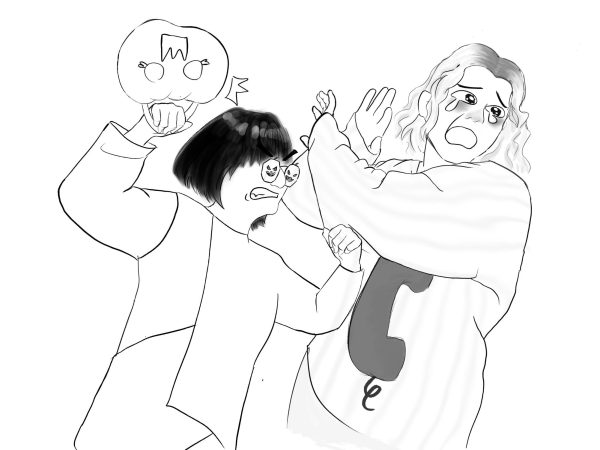Remote Learning: Why it isn’t working
March 4, 2021
On Tuesday, January 26, I worked on schoolwork all day. My first class is at 7:37 a.m., the school day ends at 11:15, I finished all of my work that was due the next day (I still had a few more things I would have liked to have progressed in) at 5:00 p.m. The 26th was also my mother’s birthday, and instead of celebrating, she had to deal with me being crabby, exhausted, and emotionally drained.
Remote learning; something that has plagued my entire senior year. My mental health has suffered immensely. I cannot focus. My motivation is low. I struggle to separate school and home life, it feels as though school never ends. The weekends are just asynchronous extensions of school. I’m overwhelmed by schoolwork. Sometimes I spend hours on one project.
Ellie Koo, a ninth-grader in Los Angelos told The New York Times, “It is really hard for [her] to separate the boundaries between school and home, and [she] often lose[s] productivity.” Even someone who lives on the opposite end of the country is experiencing the issues that myself, and many of my peers are struggling with, meaning these struggles have become universal, and even cross the line into parent and teacher struggles.
If you are a longtime reader of our school newspaper, you may remember the survey we did about remote learning in the first semester followed by the article “South students plea for remote learning leniency as district reaches second quarter”. In that survey, we found that 48.5% of students spent two or more hours on homework during remote learning compared to the 9.5% of students who spent two or more hours on homework in the 2019-2020 in-person school year.
After publishing that article, I experienced a decrease in workload, for about a month, at most, before being bombarded with work I needed to finish.
It’s not only students but teachers as well. I have talked to some of my teachers or heard them mention in passing that on certain days they work all day on grading and posting on Google Classroom, or they stay up late to catch up on work. One of my teachers had a habit of posting things at one a.m. in order to be prepared for class the next day.
According to a graphic released by the National Board for Professional Teaching Standards, 75% of teachers reported working more hours than pre-COVID-19; 20% of whom reported working an additional 15 hours or more per week.
One middle school teacher, Emma Wohl, whose school has been fully remote, told USA Today, “I spend all day staring at a screen and kind of generating enthusiasm into the void that Zoom is, and I end the day so tired, and so done, and so frustrated.”
With both students and teachers overwhelmed, the stress leaks out into the community affecting parents and siblings (who may or may not be feeling the same stress). With young students especially, parents are juggling work, household responsibilities, as well as trying to keep their children on track while monitoring their mental and physical well beings. Parents are also facing growing fears of unemployment and evictions as the year continues.
One mother and teacher tells USA Today, “I’m still the one monitoring all (my daughter’s) online dance classes and then having to throw tantrums to get other people to do chores. That definitely impacts my mental health, and my children’s, when I have to throw tantrums.”
Why is this happening? Why are so many people struggling? Well, there are many reasons, but the main one is the structure of remote learning. According to meritas.com, there are five main challenges students face during remote learning: distractions, motivation, technical issues, being left behind in class, and having diminished social aspects of being in class.
While the article only mentioned students as having these problems, teachers can also experience most of these issues. Anyone can be distracted at home; it is not the best work environment with pets and family members disrupting schoolwork, loud noises, and the allure of other activities can distract students and teachers. Teachers can also suffer motivational challenges for themselves and to get their students involved in schoolwork.
“Students on Zoom lessons often have their cameras off and microphones muted, making it harder to engage or connect with them,” according to USA Today. This lack of student-teacher interaction makes it harder for teachers to motivate their students and themselves.
Both teachers and students, often face technical issues that are out of their control. Bad connectivity, internet outages, internal computer issues, websites that may not be able to handle large amounts of traffic, and not understanding how to post or create something online plague both students and teachers. An example of this would be one of my teachers not knowing how to share audio through Zoom when watching a video. I have experienced being frozen and kicked out of Zoom during class. One of my teachers almost had to cancel the class due to connectivity issues. All of these technical issues impede learning and being able to do work in a timely fashion.
Everyone is also suffering from a lack of social interaction caused by remote learning because humans are social beings and thrive off of exchanging love, touch, and emotion with each other.
These issues have negatively affected our mental health which makes even the simplest tasks take significantly more time than it would normally, not to mention the workload for students and teachers has increased because of the remote learning schedule. With classes only lasting about 30 minutes with the new schedule, teachers are unable to fit as much into their actual class time as they need to. This has caused even more excess work to fall onto teachers and on the students.
Now with hybrid learning becoming a reality at South, some may say that is the solution, and it is – sort of. The problem is that going back to school is not that simple. You have to weigh what’s best for you and what’s best for the people around you as well.







